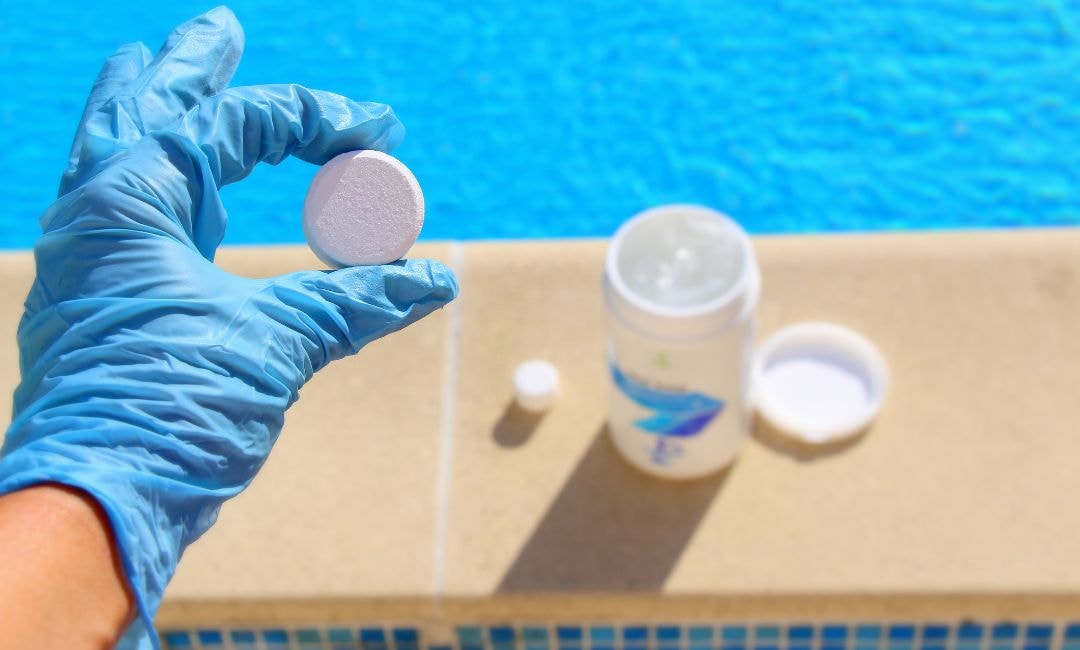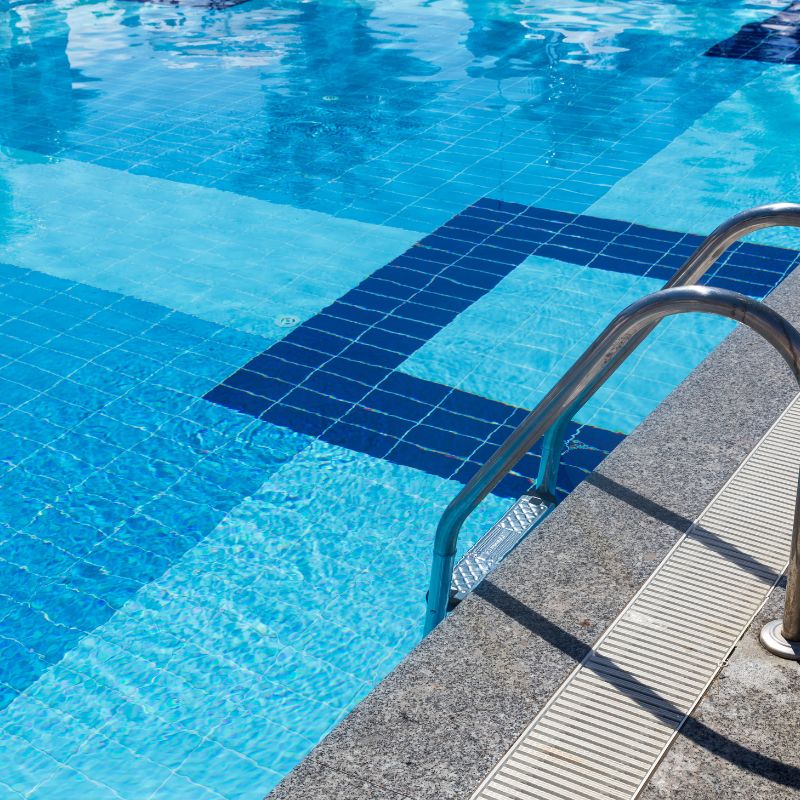Owning a pool is awesome… until it’s not. Nobody wants a swampy green mess in their backyard. But how much chlorine is too much? It’s a balancing act – too little, and you’re battling algae; too much, and you’re swimming in a chemical soup.
We’re here to help you crack the chlorine code. In this guide, we’ll break down:
- The factors that influence how much chlorine your pool needs.
- How to test your pool water and understand the results
- A simple formula to calculate the perfect chlorine dosage.
- Tips on safely adding chlorine tablets to your pool
- When to call in the pros for extra help
And if you’re in South Florida and need a helping hand with your pool, Transparent Pool Service is just a call away. We’re all about faith, integrity, quality, and reliability—and keeping your pool sparkling clean is our passion.
The Exact Amount: It’s Complicated (But We’ll Simplify It)
Every pool is unique, like a snowflake (or a margarita – your choice).
Several factors influence the ideal chlorine level for your pool:
- Pool size: Bigger pools need more chlorine. It’s basic math, really.
- Weather: Hot, sunny days break down chlorine faster than a popsicle on the 4th of July.
- Bather load: More swimmers = more sweat, sunscreen, and other… stuff that chlorine needs to neutralize.
- Type of chlorine: Different types of chlorine tablets dissolve at different rates.
- Cyanuric Acid (CYA) levels: CYA acts like sunscreen for your chlorine, protecting it from the sun’s rays. But too much CYA can make your chlorine less effective. (Think of it like wearing sunglasses at night – not helpful.)
So, what’s a pool owner to do? Don’t worry; we’ll guide you through it. But first, let’s talk about testing your pool water.
Test Your Water: It’s Like a Checkup for Your Pool

Testing your pool water is like giving it a regular checkup. It tells you what’s going on beneath the surface so you can take action before things go south.
What to test for
- Free Chlorine (FC): This is the active chlorine that’s doing the heavy lifting, sanitizing your pool, and keeping it safe for swimming.
- Total Chlorine (TC): This includes both free chlorine and combined chlorine (chloramines).
- pH: The pH level measures how acidic or basic your water is. Ideally, it should be between 7.2 and 7.8.
- Alkalinity: Alkalinity acts as a buffer for your pH, helping to keep it stable.
- Cyanuric Acid (CYA): We talked about this one earlier – it’s the chlorine’s sunscreen.
How to test
You have a couple of options:
- Test strips: These are quick and easy to use, but they’re not always the most accurate.
- Liquid test kits: These take a bit more time, but they tend to be more reliable.
Pro tip: Test your water at least twice a week, especially during heavy use or hot weather. And if you’re ever unsure about the results, don’t hesitate to reach out to a pool professional.
Speaking of professionals, Transparent Pool Service offers comprehensive pool maintenance services, including water testing and chemical balancing. We’ll take the guesswork out of keeping your pool in tip-top shape.
The Chlorine Calculation: Not as Scary as It Sounds
Let’s crunch some numbers. But don’t worry; we’ll keep it simple.
The basic formula:
- Ideal Free Chlorine (FC) level: This depends on your CYA level. Here’s a quick reference:
- CYA Level (ppm): 30-50, Minimum FC Level (ppm): 2-4
- CYA Level (ppm): 60-80, Minimum FC Level (ppm): 3-6
- CYA Level (ppm): 90-100, Minimum FC Level (ppm): 4-8
- Chlorine tablets per 10,000 gallons: This varies depending on the type and size of your tablets. Check the packaging for specific instructions.
- Your pool’s volume: If you don’t know your pool’s volume, there are online calculators that can help you figure it out.
Example:
Let’s say your pool is 20,000 gallons, your CYA level is 40 ppm, and you’re using 3-inch chlorine tablets that treat 10,000 gallons each.
- Ideal FC level: 2-4 ppm
- Tablets needed: 20,000 gallons / 10,000 gallons per tablet = 2 tablets
This is just a starting point. You may need to adjust the number of tablets based on your pool’s specific needs and the results of your water tests.
Pro tip: Start with a lower number of tablets and gradually increase until you reach your ideal FC level. It’s always easier to add more chlorine than to try and remove it.
Adding Chlorine Tablets: Safety First
Chlorine tablets are powerful stuff, so it’s important to handle them with care.
Do’s
- Wear gloves and eye protection: Chlorine can irritate your skin and eyes.
- Use a floating chlorine dispenser or an automatic chlorinator: These devices help to distribute the chlorine evenly throughout your pool.
- Store chlorine tablets in a cool, dry place: Heat and moisture can cause them to degrade and become less effective.
Don’ts
- Never mix chlorine tablets with other chemicals: This can create dangerous fumes.
- Don’t add chlorine tablets directly to your pool: This can damage your pool’s surface and cause uneven chlorine distribution.
- Don’t let chlorine tablets come into contact with your skin: If this happens, rinse the area thoroughly with water.
If you’re unsure about how to handle chlorine tablets safely, consult a pool professional or refer to the manufacturer’s instructions.
When to Call in the Pros: Sometimes You Need Backup

Maintaining a pool can be a lot of work. If you’re ever feeling overwhelmed or unsure about something, don’t hesitate to call in the pros.
Here are a few signs that it might be time to seek professional help:
- Your water is consistently cloudy or green, despite your best efforts.
- You’re having trouble balancing your pool’s chemistry.
- You’re experiencing equipment problems.
- You simply don’t have the time or energy to keep up with pool maintenance.
Remember, Transparent Pool Service is here to help. We offer a wide range of pool services, from weekly maintenance to full-scale renovations. Let us take the stress out of pool ownership so you can focus on enjoying your backyard oasis.
FAQs
What size chlorine tablets for pool floaters?
Most pool floaters are designed to hold either 1-inch or 3-inch pool chlorine tablets. 3-inch tablets are the most common choice, as they dissolve more slowly and require less frequent refilling. However, if you have a smaller pool or spa, 1-inch tablets might be a better fit.
How many chlorine tablets for the pool?
The number of chlorine tablets you need depends on several factors, including your pool size, CYA level, bather load, and weather conditions. A good starting point is 1-2 tablets per 10,000 gallons of water. But remember, it’s crucial to test your water regularly and adjust the number of tablets accordingly.
Do chlorine tablets expire?
Yes, chlorine tablets do expire. Over time, they lose their effectiveness and may not be able to maintain proper liquid chlorine levels in your swimming pool. It’s best to use them within a year or two of purchase.
Do chlorine tablets go bad?
Most chlorine tablets can go bad if they’re not stored properly. Exposure to heat, moisture, or direct sunlight can cause them to degrade and become less effective. Always store them in a cool, dry place, and keep them in their original packaging until you’re ready to use them.
Can you put too many chlorine tablets in a pool?
Absolutely. Too much chlorine can irritate your skin and eyes, and it can even damage your pool’s liner or equipment. It’s important to follow the manufacturer’s instructions and test your water regularly to ensure that your granular or liquid chlorine levels are within the safe range.
How often should I put chlorine tabs in my pool?
The frequency of adding granular chlorine tablets depends on several factors, including your pool size, CYA level, bather load, and weather conditions. In general, you’ll need to add new tablets every 3-7 days.
How long does a chlorine tablet last in the pool?
The lifespan of a chlorine tablet depends on its size, the type of chlorine it contains, and the conditions in your pool. On average, a 3-inch tablet will last 5-7 days.
Can I put 2 chlorine tablets in my pool?
You can, but it’s important to consider your pool size and the type of tablets you’re using. If you have a small pool or spa, 2 tablets might be too much. Always start with a lower number of tablets and gradually increase until you reach your ideal chlorine level.
Keep Calm and Chlorine On! Wrapping Up
Keeping your pool’s chlorine levels balanced doesn’t have to be a headache. With a little knowledge and regular testing, you can keep your swimming pool water sparkling and safe all season long.
Key takeaways
- Every pool is unique – there’s no general pool shock dosage.
- Test your water regularly to stay on top of things.
- Use the chlorine calculation formula as a starting point.
- Handle trichlor chlorine tablets with care.
- Don’t be afraid to call in the pros for help.
Need a Hand? We’re Here to Help
At Transparent Pool Service, we’re passionate about helping you enjoy your pool to the fullest. From regular maintenance to expert troubleshooting, we’ve got you covered. So go ahead, dive in, and leave the chlorine worries to us.













